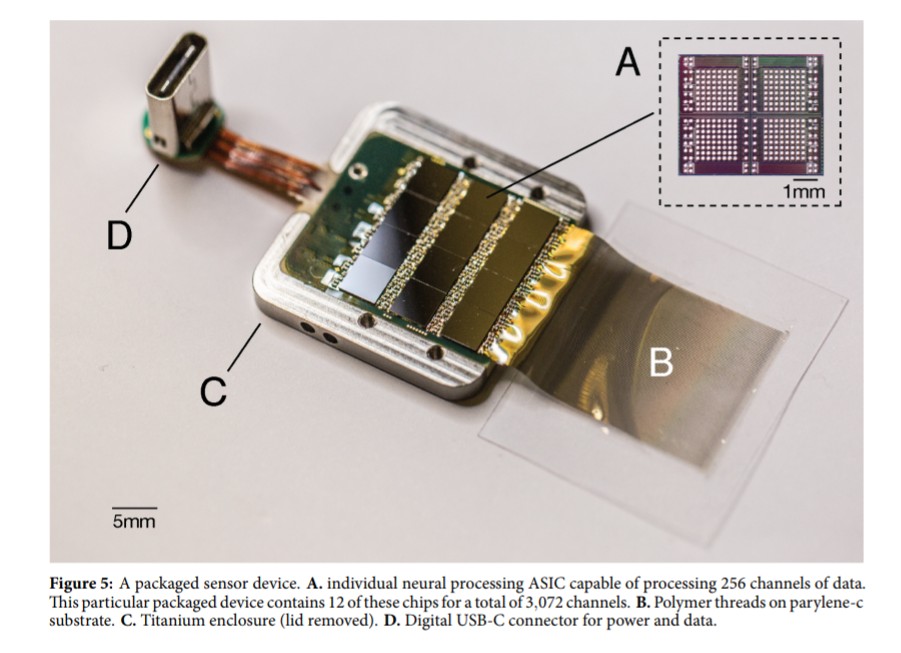Let& #39;s Talk about Neuralink.
In this week& #39;s thread, we will go through the technology, which I believe will change the future completely in a weird way and we know who can do such crazy stuff, @elonmusk
We saw the first demo of Neuralink and it& #39;s mind-blowing.
Let& #39;s dig.
In this week& #39;s thread, we will go through the technology, which I believe will change the future completely in a weird way and we know who can do such crazy stuff, @elonmusk
We saw the first demo of Neuralink and it& #39;s mind-blowing.
Let& #39;s dig.
1. Brain Machine Interfaces or BMIs have an ability for restoration of sensory and motor functions, and would be extremely useful for neurological disorders and Musk& #39;s Neuralink is the first step towards the scalable High-Bandwidth BMI system.
2. Neuralink is planning to build a chip, with arrays of small electrodes called & #39;threads& #39;, according to its white paper, the plan is to have as many as 3072 electrodes per array spread across 96 threads.
The chip will be built using the custom made neurosurgical robot.
The chip will be built using the custom made neurosurgical robot.
3. The electrode arrays of 3072 channels occupy like than (23*2*18.2) mili meter cube and it will be rechargable.
A single USB-C cable would be capable of providing data streaming from the device and also recording from all channels simultaneously.
A single USB-C cable would be capable of providing data streaming from the device and also recording from all channels simultaneously.
4. We have enough research already to that high fidelity information transfer is possible between brain and machine. Till now the drawback of building BMI system was with the inability of recording large number of neurons and hence cannot record signal deep in the brain.
5. The main three components of the Neuralink, is what makes it BMI system special.
a. Fine polymer probes.
b. Neurosurgical Robot.
c. Custom high density electronics.
The company have developed electronics which is capable of streaming data from all channels simultaneously
a. Fine polymer probes.
b. Neurosurgical Robot.
c. Custom high density electronics.
The company have developed electronics which is capable of streaming data from all channels simultaneously
6. This is the SOTA research platform and is first prototype towards fully implantable human BMI.
Let& #39;s understand a bit about those components which form a key to this success.
Let& #39;s understand a bit about those components which form a key to this success.
7. Threads:
Below is the image of how an probe would look with electrodes which form threads, the below image is called & #39;Linear Edge& #39; probe with 32 electrodes
Below is the image of how an probe would look with electrodes which form threads, the below image is called & #39;Linear Edge& #39; probe with 32 electrodes
8. Contd..
This images below shows the magnification of electrodes for the thread design in the panel and also distribution of electrodes.
This images below shows the magnification of electrodes for the thread design in the panel and also distribution of electrodes.
9. Neurosurgical Robot:
Neuralink have developed a robotic insertion approach for inserting the probes, which helps in faster and reliable way of inserting the polymer probes.
Below is how electrode inserter would look like and also some details on the same and comparision.
Neuralink have developed a robotic insertion approach for inserting the probes, which helps in faster and reliable way of inserting the polymer probes.
Below is how electrode inserter would look like and also some details on the same and comparision.
10. Electronics:
The Neuralink have developed the application specific integer circuit (ASIC), which consists of 256 programmable amplifiers, on chip digital to analog converter, and serialisation of digital outputs.
Below are few specs from Neuralink ASIC.
The Neuralink have developed the application specific integer circuit (ASIC), which consists of 256 programmable amplifiers, on chip digital to analog converter, and serialisation of digital outputs.
Below are few specs from Neuralink ASIC.
Hmm,
That& #39;s it for now.
I guess we still have lots to discuss about the Internals, but this thread would be good start for that.
I& #39;m pretty sure, things will be very interesting with this research and I& #39;m excited to see what we have in the future.
That& #39;s it for now.
I guess we still have lots to discuss about the Internals, but this thread would be good start for that.
I& #39;m pretty sure, things will be very interesting with this research and I& #39;m excited to see what we have in the future.
As, Elon Musk said on Neuralink Demo Day, "The future will be wierd and it almost feels like Black Mirror episode"
The long term plan is to have it in the form of surgery which would be similar to lasik and it would be completely normal.
The long term plan is to have it in the form of surgery which would be similar to lasik and it would be completely normal.
There are potentially very interesting applications, right from helping people with disorders to recording the dreams, erasing the memory and what not.
It& #39;s great time for the technology and I& #39;m glad to be part of it.
Thank you for visiting here and reading the thread.
It& #39;s great time for the technology and I& #39;m glad to be part of it.
Thank you for visiting here and reading the thread.
This thread is powered by BridgeTeachings.
#BridgeTeachings
#Neuralink
#ElonMusk
#AI
Thank you and Cheers https://abs.twimg.com/emoji/v2/... draggable="false" alt="🙌" title="Raising hands" aria-label="Emoji: Raising hands">
https://abs.twimg.com/emoji/v2/... draggable="false" alt="🙌" title="Raising hands" aria-label="Emoji: Raising hands">
More details here in the whitepaper paper and demo video.
Please visit.
https://www.neuralink.com/
https://www.neuralink.com/">... href="">https://youtu.be/DVvmgjBL7...
#BridgeTeachings
#Neuralink
#ElonMusk
#AI
Thank you and Cheers
More details here in the whitepaper paper and demo video.
Please visit.
https://www.neuralink.com/

 Read on Twitter
Read on Twitter









